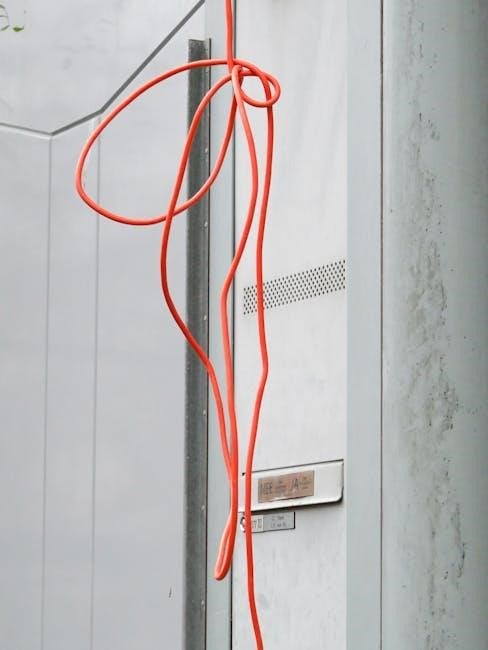Overview of Electrical Installation Condition Report (EICR)
An Electrical Installation Condition Report (EICR) is a detailed evaluation of an electrical installation’s condition, ensuring safety, compliance, and efficiency. It identifies defects, wear, and potential risks, providing actionable recommendations for property owners to maintain safe and reliable electrical systems.
Importance of EICR in Ensuring Electrical Safety
The Electrical Installation Condition Report (EICR) plays a vital role in ensuring electrical safety by identifying potential hazards and defects in an installation. It helps prevent electrical fires, shocks, and other dangers by highlighting areas that require immediate attention. Regular EICRs are essential for maintaining compliance with safety standards and regulations, such as BS 7671:2018. The report provides a clear assessment of the installation’s condition, enabling property owners to address issues before they escalate. This proactive approach not only protects people and property but also ensures the electrical system operates efficiently and safely. By conducting an EICR, landlords, employers, and homeowners can fulfill their legal obligations and create a safer environment for occupants.
Purpose and Scope of the Report
The purpose of an Electrical Installation Condition Report (EICR) is to assess the condition of an electrical installation and determine its safety for continued use. The report evaluates the installation’s compliance with current safety standards, identifying any defects or potential risks. Its scope includes a detailed inspection of electrical circuits, components, and systems, with testing to ensure they operate safely and efficiently. The report is not a certification of compliance but a factual assessment, providing recommendations for necessary repairs or upgrades. It is typically required for properties undergoing changes in occupancy or tenancy, and for periodic safety checks in commercial and industrial settings. The scope may vary based on the installation’s complexity and agreed limitations with the client, ensuring a comprehensive yet focused evaluation.
Key Components of an EICR PDF
An Electrical Installation Condition Report (EICR) PDF typically includes several key components to ensure a comprehensive assessment. These include details of the installation, such as the address, occupier, and description of the premises. The report also outlines the extent and limitations of the inspection, as agreed with the client, ensuring clarity on what was assessed. Inspection and test schedules are provided, detailing the condition of circuits, protective devices, and other components. Classification codes are used to categorize defects, with codes indicating the severity of issues found. A summary of defects and recommendations for remedial work is included, along with the inspector’s signature and qualifications. Additional sections may cover operational checks, such as the functionality of main switches and circuit protective devices, ensuring the report is thorough and actionable.

Legal and Regulatory Requirements
Electrical installations must comply with BS 7671:2018 (IET Wiring Regulations), with mandatory EICRs required for landlords and employers to ensure safety and avoid legal penalties.
Compliance with BS 7671:2018 (IET Wiring Regulations)
BS 7671:2018 (IET Wiring Regulations) sets the standard for electrical installations in the UK, ensuring safety, efficiency, and compliance. The EICR must adhere to these regulations, which outline specific requirements for inspection, testing, and reporting. The report must detail the condition of the electrical installation, identifying defects, wear, and potential hazards. It also ensures that all electrical systems meet the latest safety standards, protecting people and property from risks such as electric shock or fire. Compliance with BS 7671:2018 is mandatory for all electrical installations, and the EICR is a critical tool for verifying adherence to these standards. The report includes sections such as the extent and limitations of the inspection, agreed limitations, and classification codes for defects, providing a comprehensive assessment of the installation’s condition. By following these regulations, the EICR ensures that electrical systems are safe, reliable, and fit for continued use. Regular inspections and updates are essential to maintain compliance and address any emerging issues promptly.
Mandatory Requirements for Landlords and Employers
Landlords and employers are legally required to ensure the electrical safety of their properties and workplaces. They must arrange periodic inspections and obtain an EICR to verify compliance with safety standards. For landlords, this includes rental properties, with inspections recommended every 5 years or sooner if needed. Employers must maintain safe electrical systems to protect employees and comply with health and safety regulations. Failure to meet these obligations can result in legal penalties, fines, or even criminal charges. The EICR provides a formal record of the electrical installation’s condition, helping landlords and employers demonstrate compliance and fulfill their duties to protect occupants and users. Regular inspections are essential to identify potential hazards and prevent risks, ensuring a safe environment for tenants and employees alike.

Structure of the EICR PDF
The EICR PDF includes detailed sections like installation details, inspection results, classification codes for defects, and recommendations. It provides a clear, standardized format for documenting electrical safety assessments.
Format and Layout of the Report
The EICR PDF follows a standardized format, ensuring clarity and ease of understanding. It begins with the report reference and details of the installation, including the address and occupier information. The document is divided into clear sections, such as the extent and limitations of the inspection, inspection and testing schedules, and classification codes for defects. Each section is designed to provide a comprehensive overview of the electrical installation’s condition. The report also includes schedules that outline the results of various tests and inspections, making it easy to identify any issues. The layout is structured to guide the reader logically through the findings, ensuring that all critical information is presented in an organized manner. This standardized format helps in maintaining consistency and professionalism in the reporting process;
Detailed Sections and Schedules
The EICR PDF contains detailed sections and schedules that provide a comprehensive overview of the electrical installation’s condition. Section D outlines the extent and limitations of the inspection, agreed upon with the client, ensuring transparency. The report includes schedules that list the results of inspections and tests, such as the operation of main switches, circuit protective devices, and prospective fault currents. These schedules are organized to clearly identify any defects or potential risks. Classification codes are used to categorize findings, with codes indicating the severity of issues, such as danger or urgency. The report also includes pages dedicated to detailed observations and recommendations for remedial work. This structured approach ensures that all aspects of the electrical installation are thoroughly assessed and documented, providing a clear and actionable report for property owners or managers.

Classification Codes for Defects and Recommendations
Classification codes in the EICR PDF are essential for categorizing defects and providing clear recommendations. These codes help prioritize issues based on their severity. Code 1 indicates a dangerous condition requiring immediate attention, while Code 2 signifies a potential risk that should be addressed soon. Code 3 is used for observations that do not pose an immediate danger but may require future action. Recommendations are provided for each defect, outlining necessary repairs or improvements. This structured coding system ensures that all findings are communicated clearly and effectively, allowing property owners to take appropriate actions to ensure electrical safety. The use of standardized codes enhances consistency and compliance with regulatory standards, making the report a reliable tool for maintaining safe electrical installations. This approach ensures that all defects are addressed systematically, preventing potential hazards and ensuring ongoing safety.

Process of Conducting an EICR
The EICR process involves a thorough inspection and testing of electrical installations to assess their condition and safety. It includes visual checks, functional tests, and measurements to identify defects or potential risks, ensuring compliance with safety standards and regulations. The inspector evaluates the installation’s components, such as wiring, switches, and circuit breakers, and documents findings in a detailed report. This systematic approach ensures that any issues are detected early, preventing hazards and maintaining reliable electrical operation. The process is conducted by qualified professionals who follow specific guidelines to provide accurate and actionable results. This ensures that electrical systems remain safe for continued use.
Steps Involved in Inspection and Testing
The inspection and testing process for an EICR involves several critical steps to ensure a comprehensive assessment of the electrical installation. First, a visual inspection is conducted to identify any immediate hazards, such as damaged cables, overloaded circuits, or improper connections. This is followed by detailed testing using specialized equipment to measure electrical parameters like voltage, current, resistance, and insulation resistance. Functional tests are also performed to verify the operation of protective devices, such as circuit breakers and RCDs. The inspector checks for compliance with BS 7671:2018 standards and records all findings. Any defects or potential risks are classified using specific codes, and recommendations for remedial work are provided. The entire process is documented in a detailed report, ensuring transparency and accountability. This systematic approach ensures that the electrical installation is safe and efficient for continued use.
Responsibilities of the Inspector
The inspector is responsible for conducting a thorough and impartial assessment of the electrical installation to ensure compliance with safety standards. They must agree on the extent and limitations of the inspection with the person ordering the report, as outlined in BS 7671:2018; The inspector performs visual checks, tests, and measurements to identify defects or potential risks. They are required to classify any defects using specific codes and provide clear recommendations for remedial work. The inspector must ensure that all findings are accurately recorded in the EICR PDF, including detailed schedules and test results. Their role also involves verifying that the installation meets regulatory requirements and providing a professional opinion on its safety and condition. The inspector’s responsibilities are critical to ensuring the reliability and safety of the electrical system for its users.
